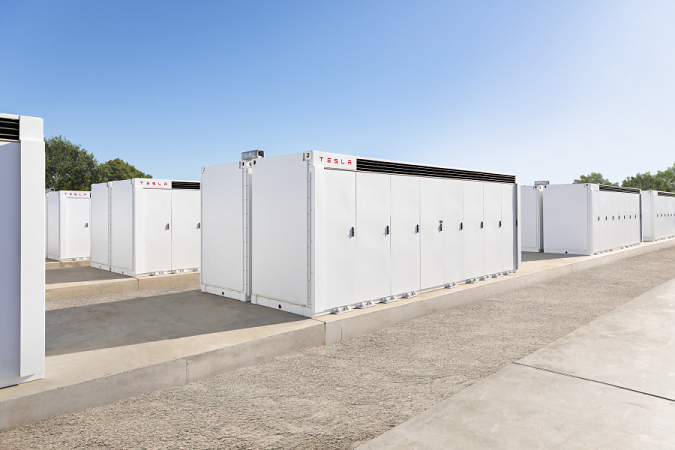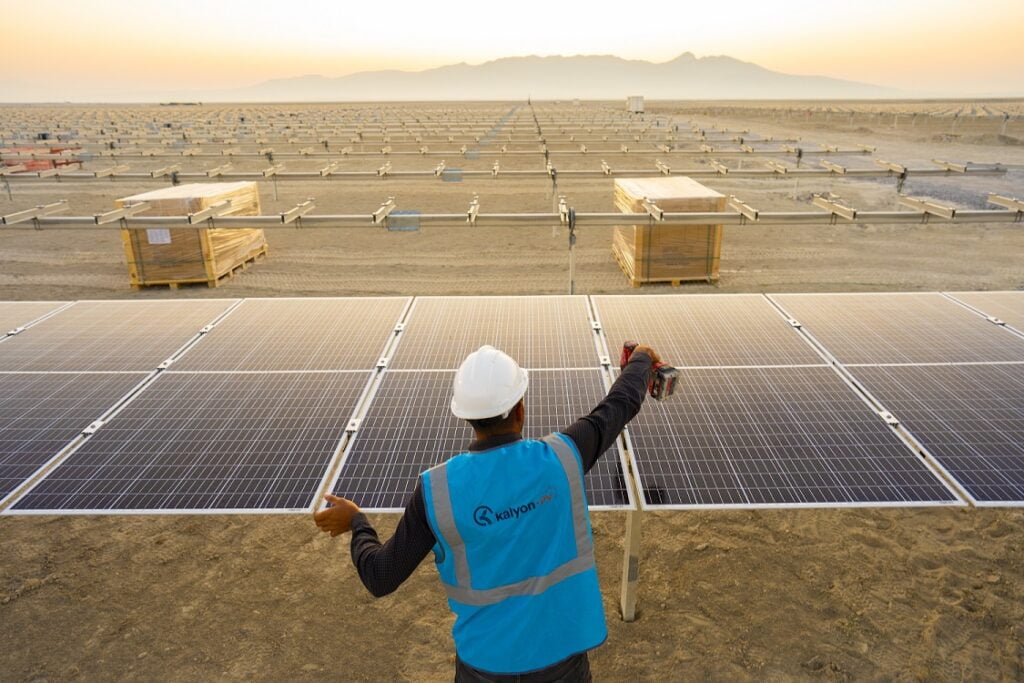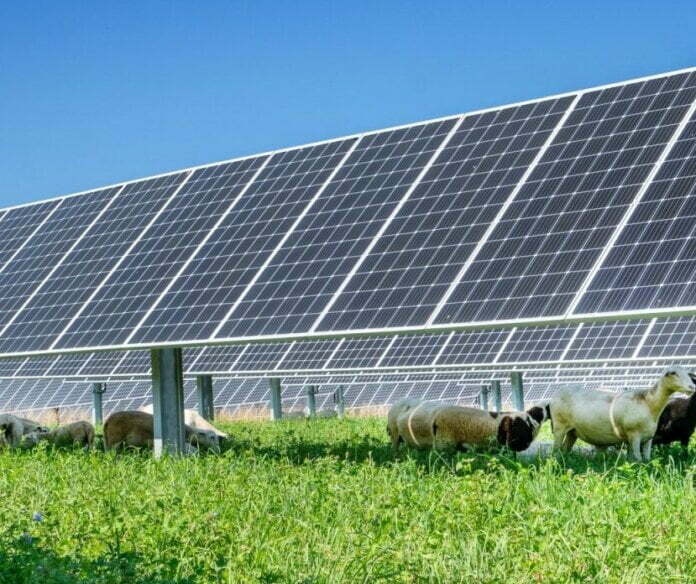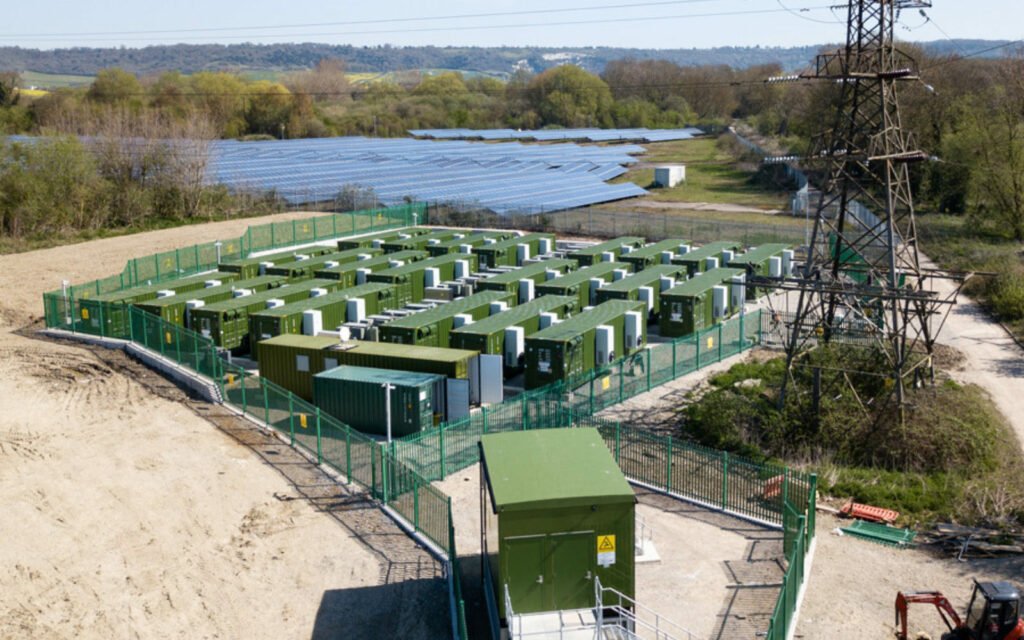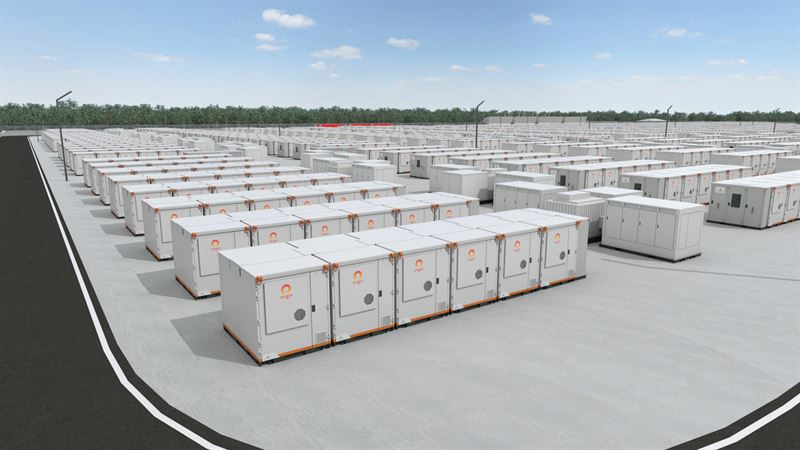Construction work at Turkey’s largest solar PV plant to date, a 1.35GW project in Karapinar. ‘Renewable energy is the trigger’ for the changes in storage regulation, Korkut Öztürkmen says. Image: Kalyon PV.
Energy-Storage.news hears why recent awards of pre-licensing for large-scale projects in Turkey mean a “very promising market” for energy storage is about to open.
The national Energy Market Regulation Authority (EMRA) issued pre-licensing for 744MW of storage from 12 applications, worth about a total investment value of US$1.5 billion, earlier this month.
Selected from more than 4,300 applications in total amounting to more than 220GW, the authority is expected to pre-license and then license 20GW of storage in Turkey over the next three years. What’s perhaps most interesting is that the storage facilities will largely be developed as co-located or hybrid resources paired with renewable energy generation.
One of the successful companies to apply is Aksa Energy, one of Turkey’s largest independent power producers (IPPs). The company received pre-licensing to install 182.24MW of wind-plus-storage projects, split across a 100.08MW project in Mersin and an 82.16MW project in Manisa.
Korkut Öztürkmen, member of the board at IPP Aksa Energy, speaks about how the EMRA, and Turkish government, listened to stakeholder input and designed what appears to be one of the biggest renewable energy and storage support programmes seen in the world so far.
Öztürkmen is also on the board of the Turkish energy generators’ association which he says worked for about four or five years on creating frameworks for energy storage, both standalone and paired with renewables, to participate in energy markets, including regulation.
In a recent report, BloombergNEF identified Turkey as one of five countries to lead energy storage development in the EMEA region to 2030, along with the UK, Germany, Italy and Greece.
Can you explain for our audience the latest developments in the Turkish market? And what are your reactions to those developments?
At this stage, I’m happy with this latest situation that we have achieved.
Now, as per the licence regulations, it is allowed for private investors to apply for storage licences, and also with the recent regulation change, if you have a regulation capacity approved by the grid operator, then investors will be also eligible to put renewable energy projects next to their storage projects in a one-to-one capacity ratio of 1MW to 1MW and 1MWh of storage to 1MWh wind or solar.
So in the coming two to three years, Turkey will be a very promising market for storage projects.
What was the reasoning behind the launch of this licensing drive?
The main reason is to support renewable energy, because until now renewable energy was tendered, the capacity was tendered in auctions and the prices were too low. Most of the projects could not be realised.
With this new regulation, if then accompanied with storage, there won’t be any auctions, no feed-in tarrif. This is a good development. These will be fully merchant power plants selling into the spot market or to commercial PPAs. So I’m very optimistic about the future.
Clearing 20,000MW of licenses of that type in three years sounds like a big undertaking, but the actual volume of 221,000MW of applications received indicates appetite for these projects is huge in Turkey.
Although there are 200,000MW of applications, there might be some overlapping projects in there. So all of those applications are needed to be cleared and redefined maybe and this will certainly take time.
My anticipation is that we will be hearing [about] kickoff of at least 20,000MW installations in the coming one or two years, after that, of course, the rest will follow.
Aksa made some applications and won just over 180MW of pre-licenses. What did a company need to do to apply for pre-licensing and then licensing? Were you required to secure land and grid connections, did projects have to be at an advanced stage of design?
For the pre-application, there are two types of projects: the first type is a project with previous applications, with storage only. Each applicant will be qualified to get at least the first 500MW of their storage applications to be accompanied or to be packaged with a wind or a solar project.
In order to provide your applications, for the first set of projects you need to have a wholesale licence; you need to be a player already in the electricity market. That is the minimum requirement.
It’s not necessary to put a bigger solar project on top of that, you can still build a storage power plant, which will be used as a balancing unit, but in order to do that, you have to have a wholesale electricity licence.
In the second set of applications, you can make an application together with specified renewable project details, accompanied by storage.
When it comes to the renewable-plus-storage [applications], you need documentation about the location, the wind or solar potential of your project to potential connection substations, and there’s a huge document list, which you need to provide, so that that application can be checked and approved first by the grid operators. The application will go to TEIAS (grid operator in Turkey) first.
TEIAS will look at the capacity of the substations that you’re proposing to put your wind or solar project. If you have a pre-approved storage licence, it is easier, but if you don’t have that, then they will check again if there is capacity left in that specific substation, and after the grid approval with affirmative response or negative response, EMRA will provide the pre-licence to that company.
If there are some overlapping projects, then projects will be notified, and they will be given a chance to change their locations, if there’s still substation capacity for both projects in that region.
For both types of applications, a letter of credit is crucial.
You don’t need to own the land but you need to specify where you will be building your solar or wind power plant: that can be private land, that can be Treasury-owned land.
During [the] licensing phase you will get first the pre-license. The most important thing for pre-licensing is the connection capacity. After that, you will use your time for about two years for wind projects, to finalise expropriation, renting the land, getting all the relevant permits to put a wind power plant there, if necessary environmental permits and so on. It takes less time for solar because in around six months or so, we can finalise all the permits that are required for solar PV, then as soon as you are licensed, you’re ready to start construction.
‘Financing of projects will depend on investors’ capability’
What is the condition of the grid in Turkey? These projects are aimed at integrating renewable energy. What sort of applications will they be performing? Will it be around managing peak demand on the grid, will they be providing ancillary services – will they perhaps combine a number of applications?
Actually for ancillary services, with the current state of the grid, we don’t need too much capacity, we need only 350MW to 400MW for primary frequency and around 2,000MW for secondary frequency.
So of course, the storage projects will also have the right to support ancillary services, they will be eligible to make bids into the ancillary services market, but the main target to put these storage units to get deliverable energy is to shift the load.
During the peak times, if there is a lot of wind or a lot of solar production, which is higher than the demand in specific hours, then the storage will be used to shift the supply to peak hours from off-peak, to balance the grid as much as possible, so that there is a continuous production or a reliable production from those renewable energy projects.
But technically I’m not very well informed whether a one-to-one ratio is enough or not for the future sustainability of the grid. There might be some changes into this ratio along the road, they can decrease it, they can increase it, they can put additional precautions to make sure the stability of the grid is sustained.
Because with this new regulation the ultimate aim of the Ministry of Energy and EMRA is to push renewable capacity over the limits of the of the grid, maybe they will in parallel to that continue to invest in the transmission lines, or they will come back to the investors and request them to optimise their production with additional storage capacity or optimise the capacity of the projects.
This also depends on the investment pipelines, because as I said, all projects will be merchant power plants, and investors have to take the market risk. There won’t be automatic PPAs or feed-in tarrif. So although there will be many megawatts of pre-licenced projects, the financing of the total capacity at the end of the day will really depend on the capability of the investors.
Both as a member of the board of Aksa Energy, and of the energy generators’ association for Turkey, you provided input to regulators on these major changes. What kind of engagement work was undertaken with the regulator and what did the regulator kind of want to know from the industry side to be able to make sort of these decisions to open up the market?
When we started to lobby to open the market for storage four years ago, our initial target was frequency control, because there is already a frequency control market in Turkey and you can make your hourly bids to the system for primary frequency and secondary frequency.
I found out that even without any incentive or any guarantee for at least the first tranche of 350MW for primary and 2,000MW for secondary frequency, there has been a viable economic business case.
So, actually, when we approached EMRA, although in the law it was possible to put up a storage power plant, by the investors, there was not secondary regulation available.
The rules and regulations of acceptance, design or response rate, or providing approval for such projects were not clear. What we have done is, as the Turkish Electricity Generators Association, which was at that time organised by myself, I organised a business trip to the German market, and we spent three days with all the market participants from Turkey.
We also brought officials from TEIAS, EMRA, Minister of Energy and everybody and we had meetings with the regulators in Germany. We met with two regulators in different regions. And also we visited some of the existing storage plants, at the time there was an installed capacity of 170MW in Germany, and they were doing fine. They were making money and they were actually stabilising the grid, also, in terms of renewable energy.
Until that visit, EMRA had the opinion that without any incentives the storage business is not a viable business, and they were working on what kind of incentives they have to provide, and because incentives were an additional burden, they were reluctant to do so.
After educating them with the feasibility studies and technical studies and examples from other markets, they were convinced and they actually started to work on opening this ancillary services market. But, of course, that’s a limited market, 350MW is not very big and if everybody invests in it, then you actually kill the market.
[At the same time], in Europe, the United States, there’s a huge jump for battery storage and Turkey might be a very strategic hub to produce those technologies. Produce even cells or package these BESS units.
In addition to that, EMRA and the Minister of Energy realised that renewable energies, although they’re supported by FiTs in the first 10 years or so, because they’re not using natural gas, or coal, or any imported raw material, in the medium term the marginal cost of such renewable energy is very low.
Previously, they were considering renewable energy as an additional burden because they had to incentivise it, they were paying two or three cents in addition to the national tariff on top of that, but then after the feed-in tariff period ended after 10 years, those power plants had to follow the market prices, and because their marginal cost was almost zero, they actually played a big role to decrease the average hourly prices in demand.
But of course, the grid was also a constraint. They started to think last year about accompanying storage with renewable energy, which was also already an example in some other countries. There were two big questions: how they will pre-license the projects and what will be the ultimate capacity ratio, renewable energy to storage.
They made a decision and now they’re taking action on that. But of course, this is only the beginning, we will see how much of the applications will be realised into real licences, and how much out of those licences will be realised as investments.
Energy-Storage.news’ publisher Solar Media will host the 1st Energy Storage Summit Asia, 11-12 July 2023 in Singapore. The event will help give clarity on this nascent, yet quickly growing market, bringing together a community of credible independent generators, policymakers, banks, funds, off-takers and technology providers. For more information, go to the website.
Continue reading


